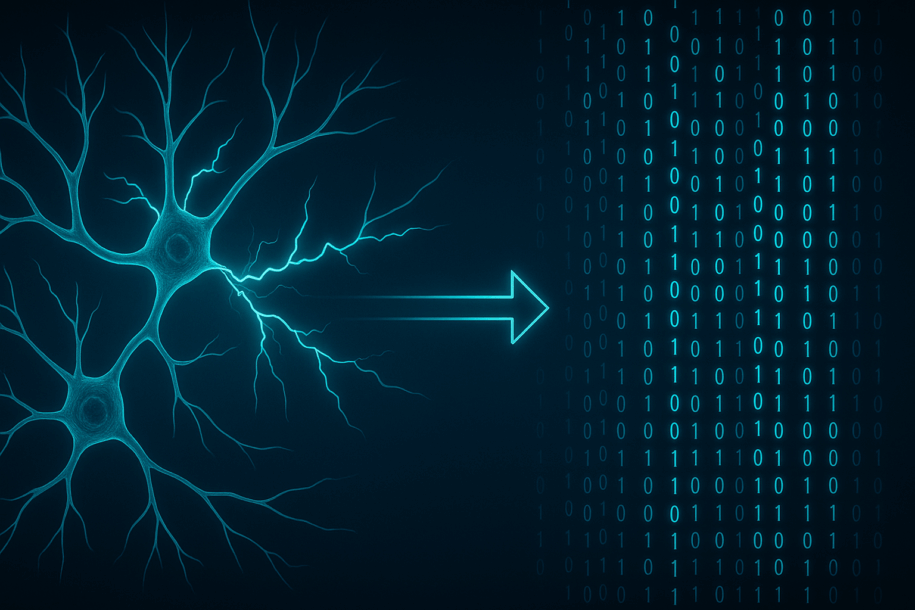Have you ever wondered how brain activity becomes the waves and numbers you see in EEG software? At BrainAccess, this is our daily challenge: transforming faint electrical whispers of the brain into clear, reliable digital data that researchers, developers, and innovators can use.
In order to understand how this works, let’s take a journey together from the scalp to the screen.
What Are We Measuring?
The brain is an electrical organ. Every thought, movement, or perception involves billions of neurons sending signals. When many neurons fire together, they create small voltage fluctuations, on the order of microvolts, that can be detected at the scalp.
These signals are incredibly weak, and easily drowned out by noise from muscle activity, blinking, or even nearby electronics. Capturing them requires precision at every step. A good set up, electrical shielding, reduced movement during recording, and artifact-removal pipelines all help insuring a good signal to noise ratio and clean data to work with.
Electrodes: Where Brain Meets Technology
The first point of contact between the brain and technology is the electrode. Without it, no signal would ever leave the scalp.
Traditional EEG systems often rely on gel-based electrodes, where a conductive paste helps bridge the gap between skin and sensor. While effective, gels are messy, time-consuming to apply, and unsuitable for portable or everyday use.
That’s why at BrainAccess, we specialize in dry electrodes, a new generation of sensors that combine comfort with research-grade quality.
Materials Matter
The performance of an electrode depends heavily on its material. Our devices are compatible with gold-plated and silver/silver-chloride (Ag/AgCl) coatings, two of the best conductors for biopotential recording.
- Gold is highly stable and resistant to corrosion, ensuring long-term durability.
- Ag/AgCl is the gold standard in medical electrodes because of its low noise and excellent skin contact properties.
Using these materials helps us minimize noise and maximize signal clarity, even without gels.
How Dry Electrodes Work
Instead of spreading gel to improve conductivity, dry electrodes use arrays of small conductive pins. Each pin makes gentle contact with the skin, capturing tiny voltage fluctuations. The signals from multiple pins are then averaged together, effectively simulating what conductive gel would do: distribute the electrical contact across a larger surface.
This design allows for reliable signal capture while keeping the system fast, clean, and easy to set up.
Different shapes for different hair types and applications
Different applications require different electrode designs. That’s why we offer dry electrodes in various shapes and contact profiles:
- Flat contacts for comfort during long-term wear.
- Pointed or pin-shaped contacts for stronger coupling through hair.
- Soft polymer-coated contacts for sensitive skin or mobile applications.
By adapting electrode geometry to the context we ensure that users always get the best balance of comfort and data quality. We make sure that the system adapts to your needs, not the other way around.
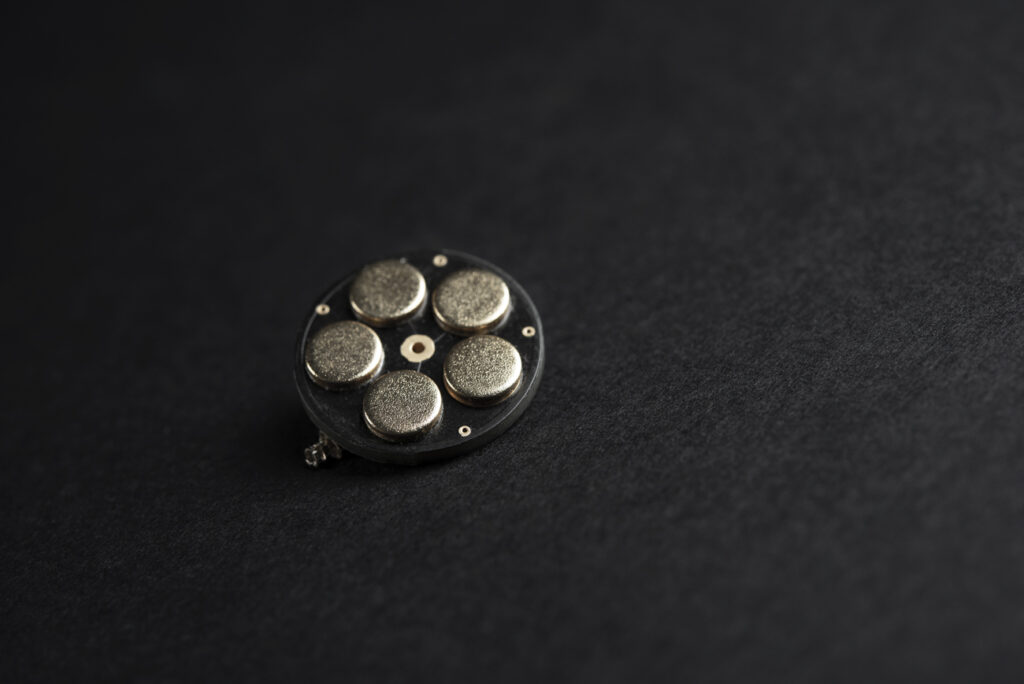
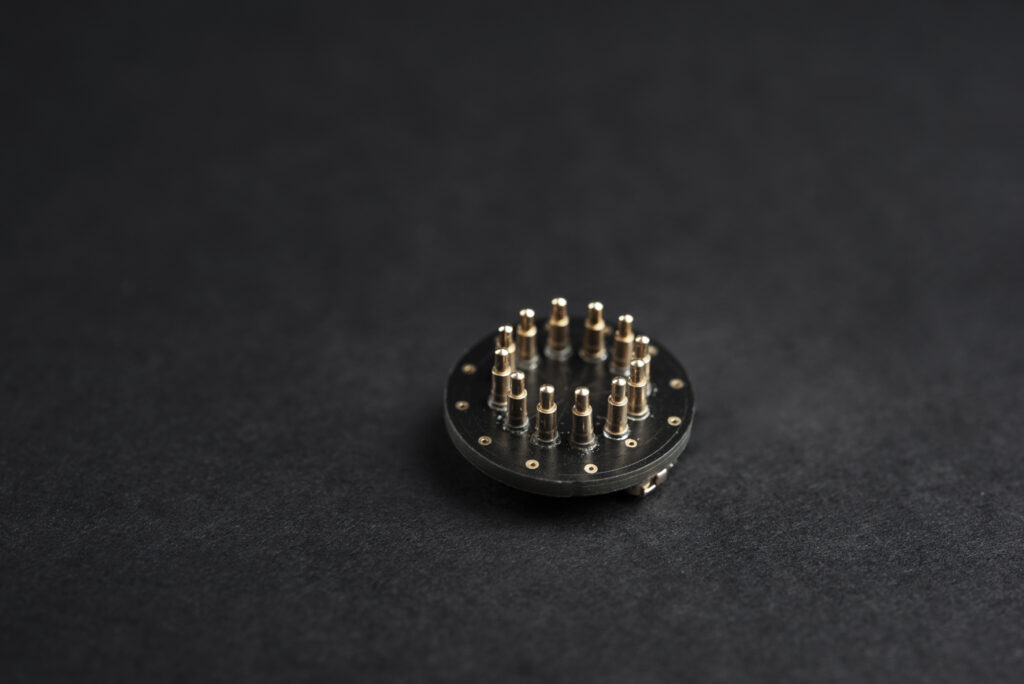
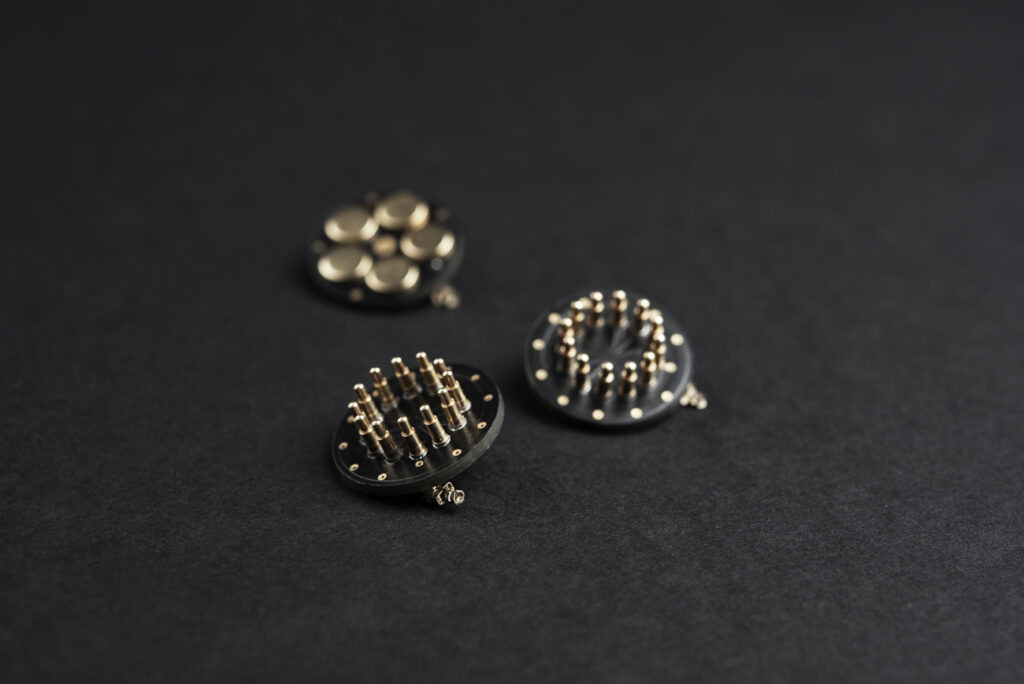
Amplification, Digitization, and Wireless Transmission
Once our dry electrodes capture the brain’s faint electrical signals, just a few microvolts in strength, the next challenge begins: making them usable. These raw signals are far too weak and easily buried under noise from the environment, muscles, or even the electronics themselves. That’s where the amplifier comes in.
Amplifier: Making Signal Stronger and Cleaner
An amplifier does exactly what the name suggests: it increases the strength of the signal without changing its shape. In EEG, this means taking a 10–50 µV fluctuation and boosting it up thousands of times so that it can be processed digitally.
EEG amplifiers don’t just make the signals stronger, they also make them cleaner. To achieve this, EEG amplifiers work on a differential principle: instead of recording absolute voltages (which would be swamped by background interference), they measure the voltage difference between electrodes. This cancels out a large portion of external noise (i.e., 50/60 Hz line noise) and isolates the actual brain activity. In addition to differential recording, BrainAccess systems use a driven bias electrode (typically at Fp1). This electrode feeds back a carefully inverted version of the common noise detected across channels, effectively canceling out interference from sources like grid electricity. By combining differential amplification with a driven bias, our devices keep brain signals clear, even in everyday environments outside shielded labs.
Just as important as amplification is filtering. Amplifiers in EEG systems are often equipped with bandpass filters that remove irrelevant frequencies (for example, very slow drifts or high-frequency noise). This ensures that what gets digitized is as close as possible to the brain’s own rhythms.
Unlike traditional systems, where amplifiers are large, wired boxes sitting next to the subject, BrainAccess integrates the entire amplification stage directly inside the headband or cap. This makes the devices small, lightweight, and fully portable, without compromising signal fidelity.
Data Conversion and Transmission
After amplification, an analog-to-digital converter (ADC) transforms the continuous brainwave into a digital stream of numbers. While brain activity is a continuous variable, EEG signal is instead discrete. The sampling rate (how many times per second the signal is measured) determines how much detail is preserved. Too low, and you miss important dynamics; too high, and you add unnecessary processing overhead.
In BrainAccess, data is transmitted wirelessly in packets of 50 samples over Bluetooth, ensuring both stability and low latency. These packets are then resampled in software to 250 Hz, a rate sufficient for most EEG research and BCI applications. And because research doesn’t stand still, our next-generation systems will support up to 1000 Hz, opening the door to high-frequency EEG analyses.
Traditionally, EEG setups meant wires running from each electrode to the amplifier, then from the amplifier to a recording computer. With BrainAccess, everything is wireless. Electrodes, amplification, and transmission are combined in a single wearable device, so researchers and developers can capture brain activity anywhere, without sacrificing precision.
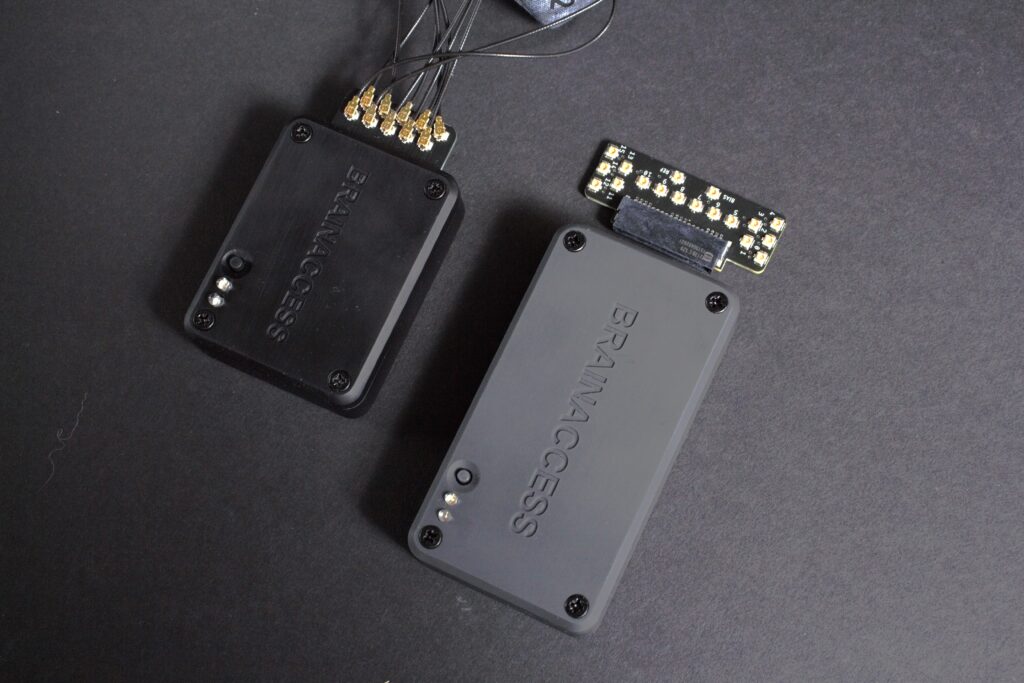
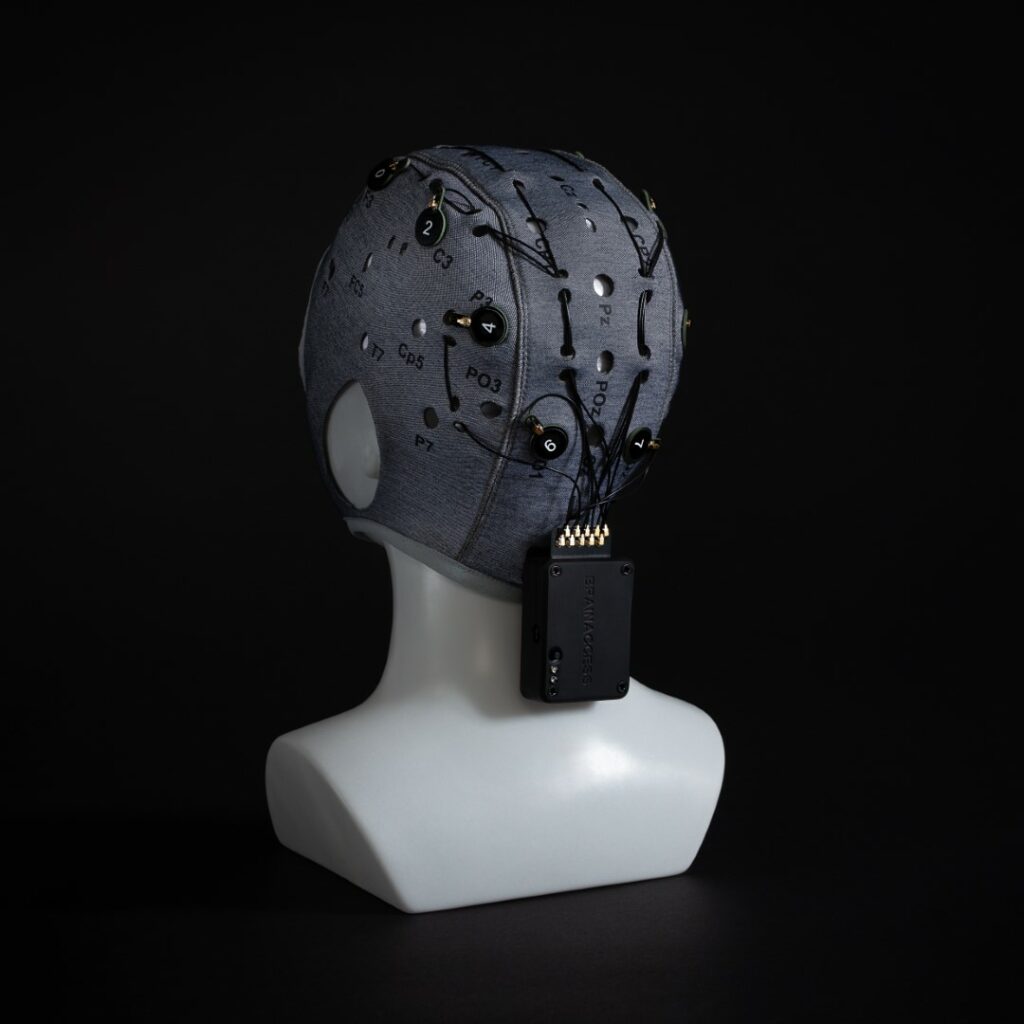
The Importance of Clean Data
A good EEG device doesn’t just record brain signals, it ensures those signals are clean, stable, and ready for analysis. Because EEG operates in the microvolt range, even the smallest disturbance can overwhelm the brain activity we want to see. That’s why every step of the setup matters.
On the hardware side, several layers of engineering work together:
- Shielded circuits protect against electromagnetic interference.
- Smart electrode design ensures stable contact with the skin.
- Ground and reference electrodes provide stability and orientation for the signals.
- Active grounding and driven bias further suppress common-mode noise.
Ground vs. Reference: Setting the Stage for EEG
In EEG, signals don’t exist in isolation, they are always measured relative to something. That’s why reference and ground electrodes are essential:
- Reference electrode: This is the comparison point for each active channel. The amplifier records the difference between an electrode and the reference electrode. Choosing the right reference location is critical, because it influences how the data looks and what brain rhythms appear strongest.
- Ground electrode: This provides the electrical baseline for the whole system, stabilizing the measurements and helping the amplifier reject interference.
Without a clear ground and reference, EEG recordings would drift, fluctuate, and pick up far more noise than signal.
Active Grounding and Bias: Making It Cleaner
A passive ground can still carry interference. With active grounding, the system monitors the noise common to all electrodes and feeds back an inverted version, stabilizing the entire recording setup. The bias electrode (in BrainAccess setups often placed at Fp1) works similarly: it injects a corrective signal that cancels out grid-related noise (50/60 Hz hum), making the recordings even cleaner.
Beyond Hardware: Software and Visualization
Even with optimal hardware, real life adds noise: eye blinks, muscle tension, or nearby electronics. That’s why software processing (digital filters, artifact rejection, advanced algorithms) is essential to refine the signal.
Finally, visualization tools bring it all together: from real-time waveforms to frequency spectra, they make the hidden patterns of brain activity visible and intuitive.
Conclusion
From Brainwaves to Bytes to Meaningful Insights
In summary, how does brain activity turn into data you can see on a screen? The journey looks like this:
- Neurons fire producing microvolt-level electrical activity at the scalp.
- Electrodes (gold-plated or Ag/AgCl dry sensors) capture this tiny signal through arrays of conductive pins.
- Reference and ground electrodes provide the baseline and stability needed for accurate measurements.
- Amplifiers boost the signal thousands of times while filtering out irrelevant noise.
- Bias and active grounding further suppress interference, ensuring the brain’s rhythms remain clear.
- ADCs (analog-to-digital converters) transform the continuous waveforms into streams of numbers.
- Wireless transmission (via Bluetooth packets) streams the data to your device, resampled in software to research-ready rates.
- Software processing filters artifacts and enhances the signal.
- Visualization tools turn the cleaned data into waveforms and power spectra.
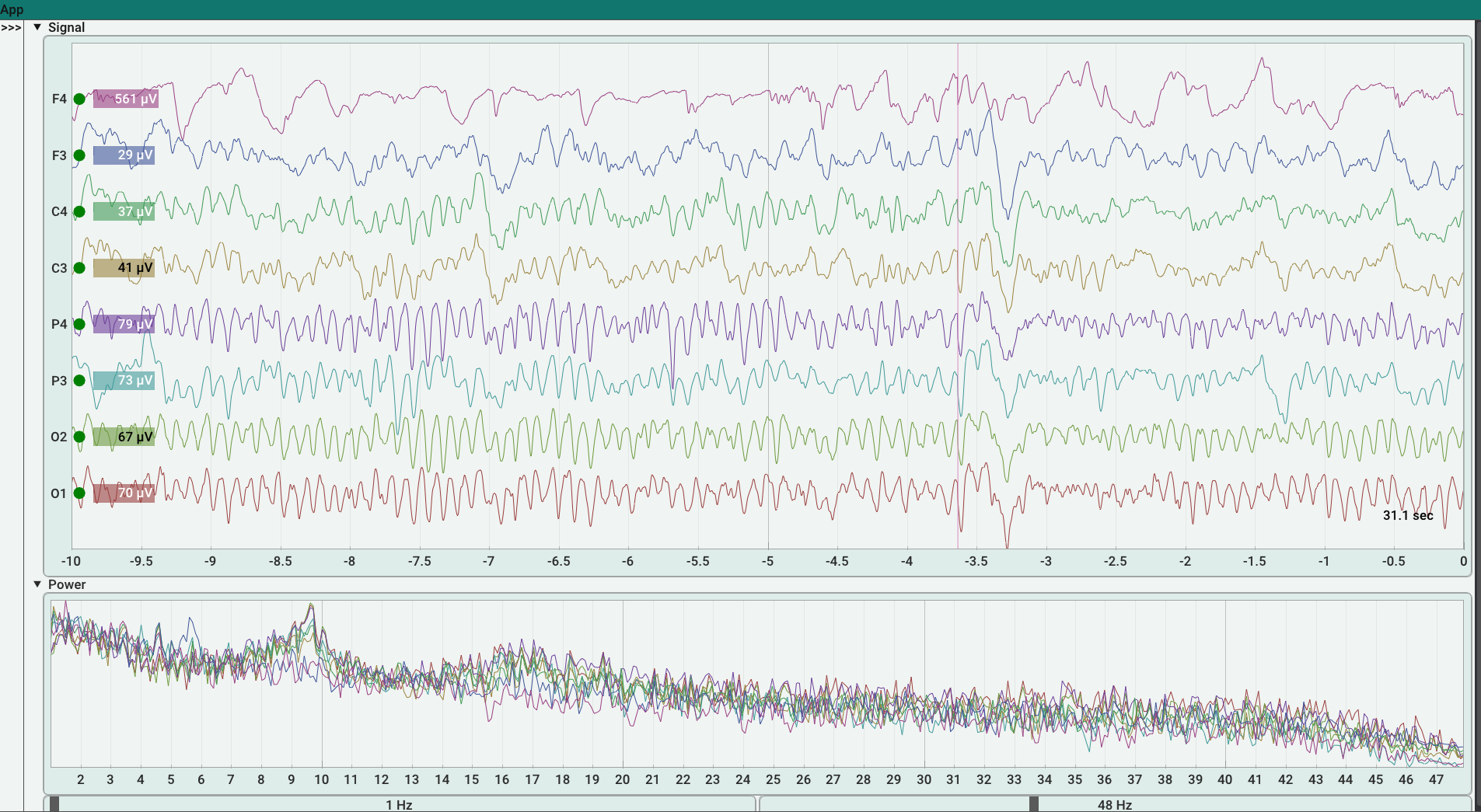
All these steps transform voltage fluctuations into data we can read and interpret to classify mental states, emotions, pathological states, stress level, relaxation, cognitive load, fatigue, and more.
Why It Matters
Every advance in electrode design, wireless integration, or signal quality pushes EEG forward. With tools like BrainAccess, researchers and developers can focus less on the complexity of data acquisition and more on unlocking insights into the human brain.
From brainwaves to bytes, we’re building the bridge between biology and technology.
Written by Martina Berto, Research Engineer and Neuroscientist for BrainAccess at Neurotecnology.

